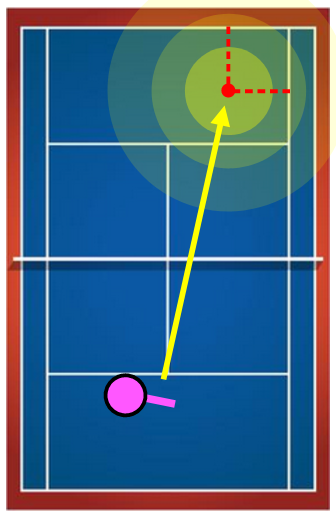For many players, the highest equity shot before adjustment when given a short, high ball up the middle is an inside-out forehand approach shot. Most players can hit their inside-out forehand reasonably well, and, equally important, most opponents don’t defend well from the backhand side.
Thus, the inside-out forehand approach shot (from a righty’s forehand to a righty’s backhand) is the best option for the attacker, the attacker’s HESBA. Before adjustment by the defender, on any given short ball, every other shot the attacker could attempt is worse than the inside-out forehand.
Defensive Adjustment
The defender can typically increase their equity in the point by preventing the attacker from hitting 100% of their forehands to the backhand side. To accomplish this, the defender must start to cheat over, often doing so right as the attacker swings.
Once this defensive adjustment is made, the attacker’s current highest equity shot changes, but their highest equity shot before adjustment has not changed. This particular adjustment leads to the cross-court forehand becoming more attractive for the attacker. It wasn’t attractive before adjustment, but now that the defender has adjusted, it is.
Mixed Strategy and the HESBA
In order to counter frequent defensive adjustment, the attacker should employ a mixed strategy. The defender’s willingness to guess with their defense prevents the 100% inside-out forehand strategy from being effective – if the attacker adopts this strategy, the defender will guess backhand side every time, and much of the attacker’s advantage will evaporate.
Therefore, the attacker needs to mix in some second best shots which are improved by the defender’s adjustment. This will prevent the attacker from being exploited by the defender’s guesses. In this case, the best candidate is probably the cross-court approach shot, (although the cross-court drop shot could work almost just as well).
Even Mixed Strategies Overweight the HESBA
In our forehand approach example, if the opponent is guessing roughly evenly between the two sides, a strategy like 60% inside-out, 40% cross-court would probably be appropriate. We don’t want to match our opponent’s defense frequency, because doing so wouldn’t leverage our HESBA – we’d be sacrificing equity by not entering our preferred pattern more than our second best pattern.
Consider two different attackers as an example.
- Attacker 1’s inside-out forehand is better
- Attacker 2’s cross-court out forehand is better
The defender is committed to guessing which way the ball will go as the attacker swings, so a 100% HESBA strategy will fail, since the defender will always end up guessing correctly.
Each attacker will use a different mixed forehand approach shot strategy. Both will mix their frequencies, lest the opponent guess correctly on every shot, but Attacker 1 will weight towards the inside-out forehand, while attacker 2 will use more cross-court.

Strategy Flows From the HESBA
When deciding how to mix your frequencies, your HESBA is your starting point. It’s the shot where your greatest advantage lies, and as such the one you’ll try to use most.
Remember, the only reason Attacker 1 is hitting any of their approach shots cross-court at all is because their opponent is cheating over to the defend backhand side. They’d like for him to stand in the middle so that they could hit every ball to the backhand, the pattern where they win most.
So even after their opponent adjusts, the inside-out forehand is still going to be a good shot, just not as good as if their opponent hadn’t adjusted at all. The attacker is still going to use the inside-out forehand, a lot in any mixed strategy, just not as much as they would if their opponent was still just waiting in the center.
We want to feel a sort of force pulling us towards using our HESBA throughout the match. Our opponents will adjust to it, and we’ll mix in other shots to counter those adjustments, but by always remembering our HESBA, and knowing why we have it, we should be able to avoid over-strategizing ourselves out of an easy win.




